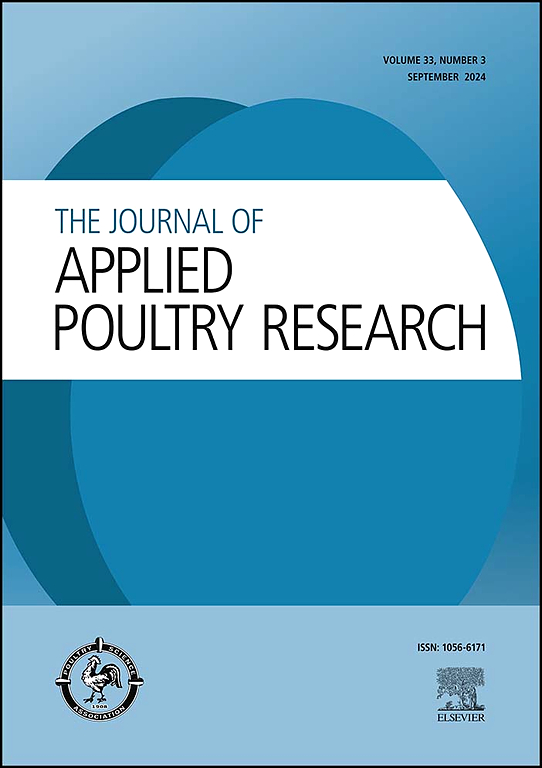Free-range rearing characteristics of two German dual-purpose chicken breeds: Dresden chickens and Dresden bantams
IF 2
3区 农林科学
Q2 AGRICULTURE, DAIRY & ANIMAL SCIENCE
引用次数: 0
Abstract
This study characterized the rearing of two dual-purpose chicken breeds, Dresden chickens (DrChi) and Dresden bantams (DrBa), in terms of growth and slaughter performance and integument condition under extensive free-range conditions. The trial consisted of two rearing groups with 173 DrChi and 197 DrBa, which were reared over a period of 20 weeks. Additionally, 50 slow-growing Cobb Sasso™ (CoSa) broilers served as the control group until week 10. DrChi reached body weights of 2,293.1 ± 356.4 g (roosters) and 1,777.9 ± 201.8 g (hens), while DrBa weighed 1,223.1 ± 120.0 g (roosters) and 880.0 ± 121.9 g (hens) by week 20. The growth data were fitted to a re-parameterized Gompertz function. As a result, the maximum daily weight gain were calculated at 19.5 g, 14.5 g, 9.8 g, and 7.1 g, at week of age 9.5, 10.2, 9.2, and 8.9 for male and female DrChi and DrBa, respectively. Using binary logistic regression models, breed and age showed significant differences in plumage damage (p < 0.001 each). In the evaluation of the slaughter data, the effects of breed were found both in terms of the carcass yield (DrChi: 64.4 %; DrBa: 59.8 %; CoSa: 72.5 %; p < 0.014) and in the proportions of valuable cuts (breast filet—DrChi: 14.5 %; DrBa: 16.7 %; CoSa: 24.9 %; p < 0.001; thigh meat—DrChi: 34.7 %; DrBa: 31.4 %; CoSa: 30.0; p < 0.001). In conclusion, both local breeds were suitable for extensive rearing and could be an option for local direct marketing.
德国两种两用鸡品种德累斯顿鸡和德累斯顿班塔姆鸡的散养特性
本研究对德累斯顿鸡(DrChi)和德累斯顿班塔姆鸡(DrBa)这两个双重用途鸡品种在散养条件下的生长、屠宰性能和被皮状况进行了研究。试验分为2个饲养组,分别饲喂173头DrChi和197头DrBa,饲养周期为20周。另外,50只生长缓慢的Cobb Sasso™(CoSa)肉鸡作为对照组,直到第10周。第20周时,DrChi的体重分别为2293.1±356.4 g(公鸡)和1777.9±201.8 g(母鸡),DrBa的体重分别为12223.1±120.0 g(公鸡)和880.0±121.9 g(母鸡)。生长数据拟合到一个重新参数化的Gompertz函数。结果表明,雄性和雌性DrChi和DrBa在9.5、10.2、9.2和8.9周龄时的最大日增重分别为19.5 g、14.5 g、9.8 g和7.1 g。使用二元logistic回归模型,品种和年龄在羽毛损伤方面存在显著差异(p <;0.001每个)。在屠宰数据的评价中,品种的影响体现在胴体产量方面(DrChi: 64.4%;DrBa: 59.8%;CoSa: 72.5%;p & lt;0.014)和有价值的部位的比例(胸肉- dr . chi: 14.5%;DrBa: 16.7%;CoSa: 24.9%;p & lt;0.001;大腿肉- dr - chi: 34.7%;DrBa: 31.4%;科:30.0;p & lt;0.001)。总之,这两个地方品种都适合广泛饲养,可以作为地方直销的选择。
本文章由计算机程序翻译,如有差异,请以英文原文为准。
求助全文
约1分钟内获得全文
求助全文
来源期刊

Journal of Applied Poultry Research
农林科学-奶制品与动物科学
CiteScore
4.10
自引率
10.50%
发文量
80
审稿时长
104 days
期刊介绍:
The Journal of Applied Poultry Research (JAPR) publishes original research reports, field reports, and reviews on breeding, hatching, health and disease, layer management, meat bird processing and products, meat bird management, microbiology, food safety, nutrition, environment, sanitation, welfare, and economics. As of January 2020, JAPR will become an Open Access journal with no subscription charges, meaning authors who publish here can make their research immediately, permanently, and freely accessible worldwide while retaining copyright to their work. Papers submitted for publication after October 1, 2019 will be published as Open Access papers.
The readers of JAPR are in education, extension, industry, and government, including research, teaching, administration, veterinary medicine, management, production, quality assurance, product development, and technical services. Nutritionists, breeder flock supervisors, production managers, microbiologists, laboratory personnel, food safety and sanitation managers, poultry processing managers, feed manufacturers, and egg producers use JAPR to keep up with current applied poultry research.
 求助内容:
求助内容: 应助结果提醒方式:
应助结果提醒方式:


